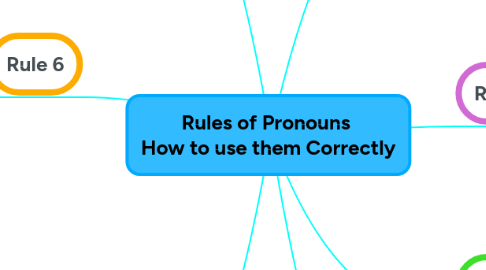
1. Rule 5
1.1. When the object of a verb or of a preposition is a pronoun, it must be in objective form
1.2. Example
1.2.1. Let you and me (not I) start the work.
1.2.1.1. pronoun *you* and *me* are used as an object of the verb *let* in this sentence, hence they should be in objective form
1.2.1.2. Note- Objective form of *you* is *you* only
1.2.2. Between you and me (not I), the problem could have sorted out
1.2.2.1. *you* and *me* are object of preposition *between*
2. Rule 6
2.1. The Relative Pronoun *who* is used to refer to a person performing the action
2.1.1. while *whom* is used to refer to the receiver of the action
2.2. Example
2.2.1. The Person *whom* you met yesterday has just gone out
2.2.1.1. The person is the receiver of the action *met*, hence *whom is used
2.2.2. He told me *who* had attacked him
2.2.2.1. The person performing the action attacked, hence *who* is used
3. Rule 7
3.1. Relative pronouns *which* and *that* are used to refer to a place, thing or idea.
3.1.1. The Relative pronoun *that* is used to introduce some essential information about its antecedent
3.1.1.1. Removing this will render the sentence with altered or no meaning
3.1.2. The Relative pronoun *which* is used to introduce information that is not very important
3.1.2.1. Removing this will not harm the sentence much
3.2. When using the Relative pronoun *that*
3.2.1. Do NOT place a Comma before *that*
3.3. When using the Relative pronoun *which*
3.3.1. Do place a Comma before *which*
3.4. Example
3.4.1. Simi found the necklace that (not which) she had lost
3.4.1.1. Pronoun *that* introduces information about the necklace
3.4.2. I bought a dress, which (not that) is blue in color.
3.4.2.1. Pronoun *which* introduces additional information about the dress
4. Rule 1
4.1. A pronoun in a sentence should clearly refer to only one corresponding noun or pronoun
4.1.1. There should not be any uncertainties or vagueness in determining pronouns in a sentence
4.2. Example
4.2.1. Kamla and vimla went for dinner at a restaurant, but *she* did not like the food
4.2.1.1. This sentence is incorrect
4.2.1.2. Here *she* is confusing, since it is not clear whether *she* refers to kamla or vimla
4.2.2. Correction- Kamla and vimla went for dinner at a restaurant, but *they* did not like the food
4.2.2.1. Kamla and vimla went for dinner at a restaurant, but *Kamla* did not like the food
5. Rule 2
5.1. Indefinite pronouns are always considered singular
5.1.1. these include another, anything, everything, something, anyone, someone, nothing, no one, neither, either, each, one etc
5.2. Example
5.2.1. We are ready to assist *everyone* of our daughters in *her* studies
5.2.1.1. Since *everyone* is considered singular, pronoun *her* will be used
6. Rule 3
6.1. If indefinite pronoun *one* is used in a sentence, it should be used throughout the sentence
6.2. Example
6.2.1. *One* should obey the rules and regulations of *one's* company
7. Rule 4
7.1. When pronoun is part of subject or is being used as a subject, it must be in subjective form
7.2. Example
7.2.1. Rosy and *I* (not me) visited John last month
7.2.1.1. The pronoun *I* is being used as a subject, hence should be in subjective form
7.2.1.2. *Me* cannot be used since it is in objective form
